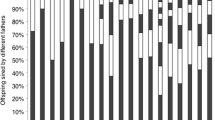Abstract
We investigated multiple paternity and sperm precedence in the Amarillo fish, Girardinichthys multiradiatus (Goodeidae). We allowed females to mate with two different-sized males consecutively and assessed the paternity of the ensuing broods using allozyme electrophoresis. We presented one-half of the females the larger, and the other half the smaller, male first. Allozyme variation among individuals was low, yielding conservative estimates of multiple paternity. Half the broods were of mixed paternity, but one male always sired more than 70% of the embryos in each brood. The proportion of the brood sired was not related to mating sequence, but when we classified males by relative size, the larger male of each pair usually fathered greater proportions of offspring than the smaller male. This association disappeared when we used the actual size of the males in the analysis. Instead, for any pair of males, the difference in number of offspring sired was correlated to differences in the rate of courtship displays, rather than size differences, suggesting that courtship intensity is a better predictor of paternity than male size. Within a pair, the larger male usually displayed more than the smaller one, but there was no correlation between male size and display rate across all males. Parsimony suggests a correlation between courtship rate and sperm production, but we cannot rule out the possibility that females allocate paternity according to the relative merits of the males.
Similar content being viewed by others
References
Bakker, T.C.M. & M. Milinski. 1991. Sequential female choice and the previous male effect in sticklebacks. Behav. Ecol. Sociobiol. 29: 205-210.
Bisazza, A. 1997. Sexual selection constrained by internal fertilization in the livebearing fish Xenotoca eiseni. Anim. Behav. 54: 1347-1355.
Colegrave, N., T.R. Birkhead & C.M. Lessells. 1995. Sperm precedence in zebra finches does not require special mechanisms of sperm competition. Proc. R. Soc. Lond. B. 259: 223-228.
Constantz, G.D. 1984. Sperm competition in poeciliid fishes. pp. 465-485. In: R.L. Smith (ed.) Sperm Competition and the Evolution of Animal Mating Systems, Academic Press, London.
Constantz, G.D. 1989. Reproductive biology of poeciliid fishes. pp. 33-50. In: G.K. Meffe & F.S. Snelson, Jr. (ed.) Ecology and Evolution of Livebearing Fishes (Poeciliidae), Prentice Hall, New Jersey.
Eberhard, W.G. 1996. Female Control: Sexual Selection by Cryptic Female Choice, Princeton University Press, Princeton. 501 pp.
Evans, J.P., L. Zane, S. Francescato & A. Pilastro. 2003. Directional postcopulatory sexual selection revealed by artificial insemination. Nature 421: 360-363.
Farr, J.A. 1976. Social facilitation of male sexual behavior, intrasexual competition, and sexual selection in the guppy, Poecilia reticulata (Pisces: Poeciliidae). Evolution 30: 707-717.
Farr, J.A. 1980. Social behavior patterns as determinants of reproductive success in the guppy, Poecilia reticulata Peters (Pisces: Poeciliidae). An experimental study of the effects of intermale competition, female choice, and sexual selection. Behaviour 74: 39-91.
Farr, J.A. & W.F. Herrnkind. 1974. A quantitative analysis of social interactions of the guppy, Poecilia reticulata (Pisces: Poeciliidae) as a function of population density. Anim. Behav. 22: 582-591.
Fitzsimons, J.M. 1972. A revision of two genera of goodeid fishes (Cyprinodontiformes, Osteichthyes) from the Mexican Plateau. Copeia 1972: 728-756.
Grudzien, T.A. & B.J. Turner. 1984a. Direct evidence that the Ilyodon morphs are a single biological species. Evolution 38: 402-407.
Grudzien, T.A. & B.J. Turner. 1984b. Genetic identity and geographic differentiation of trophically dichotomous Ilyodon (Teleostei: Goodeidae). Copeia 1984: 102-107.
Hillis, D.M., C. Moritz & B.K. Mable (ed.) 1996. Molecular Systematics, Sinauer Associates, Inc. Publishers, Massachusetts. 588 pp.
Halliday, T.R. 1983. The study of mate choice. pp. 3-32. In: P. Bateson (ed.) Mate Choice, Cambridge University Press, London.
Hubbs, C.L. & C.L. Turner. 1939. Studies of the fishes of the order Cyprinodontiformes. XVI. A revision of the Goodeidae. Miscellaneous Publications of the Museum of Zoology, University of Michigan 42. 72 pp.
Janetos, A.C. 1980. Strategies of female mate choice: A theoretical analysis. Behav. Ecol. Sociobiol. 21: 211-216.
Macías Garcia, C. 1991. Sexual behaviour and trade-offs in the viviparous fish Girardinichthys multiradiatus. Ph.D. thesis, Norwich, University of East Anglia. England. 135 pp.
Macías Garcia, C. 1994. Social behavior and operational sexratios in the viviparous fish Girardinichthys multiradiatus. Copeia 1994: 919-925.
Macías Garcia, C., G. Jimenez & B. Contreras. 1994. Correlational evidence of a sexually-selected handicap. Behav. Ecol. Sociobiol. 35: 253-259.
Macías Garcia, C., E. Saborío & C. Berea. 1998. Does malebiased predation lead to male scarcity in viviparous fish? J. Fish Biol. 53(Suppl. A): 104-117.
Macías Garcia, C. & A. Valero. 2001. Context-dependent sexual mimicry in the viviparous fish Girardinichthys multiradiatus. Ethol. Ecol. Evol. 13: 331-339.
Macías Garcia, C & Burt de Perera, T. 2002. Ultraviolet-based female preferences in a viviparous fish. Behav. Ecol. Sociobiol. 52: 1-6.
Marshall, T.C., J. Slate, L. Kruuk & J.M. Pemberton. 1998. Statistical confidence for likelihood-based paternity inference in natural populations. Mol. Ecol. 7: 639-655.
Matthews, I.M., J.P. Evans & A.E. Magurran. 1997. Male display rate reveals ejaculate characteristics in the Trinidadian guppy Poecilia reticulata. Proc. R. Soc. Lond. B. 264: 695-700.
Mazalov, V., N. Perrin & Y. Dombrowsky. 1996. Adaptive search and information updating in sequential mate choice. Amer. Nat. 148: 123-137.
Mendoza, G. 1939. The reproductive cycle of the viviparous teleost, Neotoca bilineata, a member of the family Goodeidae. Biol. Bull. 76: 359-370.
Mendoza, G. 1962. The reproductive cycles of three viviparous teleosts, Alloophorus robustus, Goodea luitpoldii and Neoophorus diazi. Biol. Bull. 123: 351-365.
Sullivan, M.S. 1994. Mate choice as an information gathering process under time constraint: Implications for behaviour and signal design. Anim. Behav. 47: 141-151.
Tinbergen, N. 1951. The Study of Instinct, Clarendon Press, Oxford. 228 pp.
Turner, B.J. & Williams, G.C. 1966. Adaptation and Natural Selection: A Critique of Some Current Evolutionary Thought, Princeton University Press. 307 pp.
Wittenberger, J.F. 1983. Tactics of mate choice. pp. 435-447. In: P. Bateson (ed.) Mate Choice, Cambridge University Press, London.
Author information
Authors and Affiliations
Rights and permissions
About this article
Cite this article
Macías-Garcia, C., Saborío, E. Sperm Competition in a Viviparous Fish. Environmental Biology of Fishes 70, 211–217 (2004). https://doi.org/10.1023/B:EBFI.0000033335.58813.fc
Issue Date:
DOI: https://doi.org/10.1023/B:EBFI.0000033335.58813.fc




